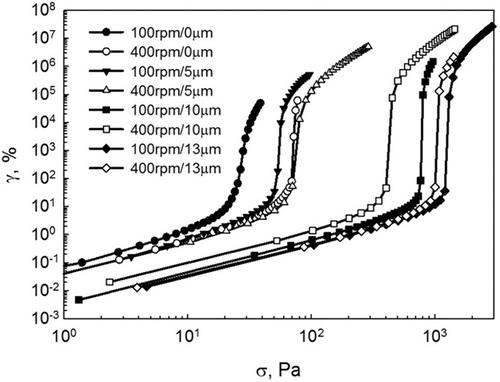当前位置:
X-MOL 学术
›
Polym. Eng. Sci.
›
论文详情
Our official English website, www.x-mol.net, welcomes your
feedback! (Note: you will need to create a separate account there.)
Effect of ultrasonic extrusion on properties of colloids and bio‐based nanocomposites containing epoxidized soybean oil and nanoclay
Polymer Engineering and Science ( IF 3.2 ) Pub Date : 2021-01-16 , DOI: 10.1002/pen.25633 Tian Liang 1 , Avraam I. Isayev 1 , Shuailin Zhang 2 , Stephen Z. D. Cheng 2
Polymer Engineering and Science ( IF 3.2 ) Pub Date : 2021-01-16 , DOI: 10.1002/pen.25633 Tian Liang 1 , Avraam I. Isayev 1 , Shuailin Zhang 2 , Stephen Z. D. Cheng 2
Affiliation

|
Colloid prepared with epoxidized soybean oil (ESO) and a nanoclay, organically modified montmorillonite (OMMT), has been processed using an ultrasonic twin‐screw extruder under various ultrasonic amplitudes and screw rotation speeds. Ultrasonic treatment has significantly increased OMMT dispersion in ESO, according to wide angle X‐ray diffraction and rheological data. Yield stress, storage and loss modulus, and complex viscosity and relaxation time of the colloid have been increased with increase of ultrasonic amplitude. Under certain high ultrasonic amplitudes, the increase of one to two orders of magnitude in the above‐mentioned properties of colloids has been observed. Creep and recoverable compliance have been decreased with the increase of ultrasonic amplitude. The tremendous changes in rheological properties of the colloid are a result of significantly improved OMMT dispersion with the aid of ultrasonic treatment. With no or low ultrasonic treatment, a higher screw rotation speed has improved OMMT dispersion since it brings more mixing effect. However, at high ultrasonic amplitudes, a higher rotation disrupts jet flow and has led to less dispersion improvement compared with the same colloid extruded at a lower rotation speed. Colloids extruded at 400 rpm were cured using triethylenetetramine to prepare bio‐based nanocomposites. The nanocomposite prepared using colloid treated at 13 μm shows improved tensile strength and modulus compared with the nanocomposite prepared using untreated colloid.
中文翻译:

超声挤压对含环氧化大豆油和纳米粘土的胶体和生物基纳米复合材料性能的影响
使用环氧化大豆油(ESO)和纳米粘土,有机改性蒙脱土(OMMT)制备的胶体已使用超声双螺杆挤出机在各种超声振幅和螺杆转速下进行了加工。根据广角X射线衍射和流变数据,超声波处理显着增加了OMMT在ESO中的分散性。随着超声振幅的增加,胶体的屈服应力,储能和损耗模量以及复数粘度和弛豫时间都增加了。在某些高超声振幅下,已观察到上述胶体特性增加了一个到两个数量级。随着超声振幅的增加,蠕变和可恢复的柔度已降低。胶体流变性质的巨大变化是借助超声处理大大改善了OMMT分散性的结果。在不进行超声波处理或不进行超声波处理的情况下,较高的螺杆转速可带来更大的混合效果,从而改善了OMMT的分散性。然而,与以较低旋转速度挤出的相同胶体相比,在较高的超声波振幅下,较高的旋转会干扰射流,并导致分散性改善较少。使用三亚乙基四胺固化以400 rpm挤出的胶体,以制备生物基纳米复合材料。与使用未处理的胶体制备的纳米复合材料相比,使用13μm处理的胶体制备的纳米复合材料显示出改善的拉伸强度和模量。更高的螺杆转速带来了更多的混合效果,从而改善了OMMT分散性。然而,与以较低旋转速度挤出的相同胶体相比,在较高的超声波振幅下,较高的旋转会干扰射流,并导致分散性改善较少。使用三亚乙基四胺固化以400 rpm挤出的胶体,以制备生物基纳米复合材料。与使用未处理的胶体制备的纳米复合材料相比,使用13μm处理的胶体制备的纳米复合材料显示出改善的拉伸强度和模量。更高的螺杆转速带来了更多的混合效果,从而改善了OMMT分散性。然而,与以较低旋转速度挤出的相同胶体相比,在较高的超声波振幅下,较高的旋转会干扰射流,并导致分散性改善较少。使用三亚乙基四胺固化以400 rpm挤出的胶体,以制备生物基纳米复合材料。与使用未处理的胶体制备的纳米复合材料相比,使用13μm处理的胶体制备的纳米复合材料显示出改善的拉伸强度和模量。使用三亚乙基四胺固化以400 rpm挤出的胶体,以制备生物基纳米复合材料。与使用未处理的胶体制备的纳米复合材料相比,使用13μm处理的胶体制备的纳米复合材料显示出改善的拉伸强度和模量。使用三亚乙基四胺固化以400 rpm挤出的胶体,以制备生物基纳米复合材料。与使用未处理的胶体制备的纳米复合材料相比,使用13μm处理的胶体制备的纳米复合材料显示出改善的拉伸强度和模量。
更新日期:2021-01-16
中文翻译:

超声挤压对含环氧化大豆油和纳米粘土的胶体和生物基纳米复合材料性能的影响
使用环氧化大豆油(ESO)和纳米粘土,有机改性蒙脱土(OMMT)制备的胶体已使用超声双螺杆挤出机在各种超声振幅和螺杆转速下进行了加工。根据广角X射线衍射和流变数据,超声波处理显着增加了OMMT在ESO中的分散性。随着超声振幅的增加,胶体的屈服应力,储能和损耗模量以及复数粘度和弛豫时间都增加了。在某些高超声振幅下,已观察到上述胶体特性增加了一个到两个数量级。随着超声振幅的增加,蠕变和可恢复的柔度已降低。胶体流变性质的巨大变化是借助超声处理大大改善了OMMT分散性的结果。在不进行超声波处理或不进行超声波处理的情况下,较高的螺杆转速可带来更大的混合效果,从而改善了OMMT的分散性。然而,与以较低旋转速度挤出的相同胶体相比,在较高的超声波振幅下,较高的旋转会干扰射流,并导致分散性改善较少。使用三亚乙基四胺固化以400 rpm挤出的胶体,以制备生物基纳米复合材料。与使用未处理的胶体制备的纳米复合材料相比,使用13μm处理的胶体制备的纳米复合材料显示出改善的拉伸强度和模量。更高的螺杆转速带来了更多的混合效果,从而改善了OMMT分散性。然而,与以较低旋转速度挤出的相同胶体相比,在较高的超声波振幅下,较高的旋转会干扰射流,并导致分散性改善较少。使用三亚乙基四胺固化以400 rpm挤出的胶体,以制备生物基纳米复合材料。与使用未处理的胶体制备的纳米复合材料相比,使用13μm处理的胶体制备的纳米复合材料显示出改善的拉伸强度和模量。更高的螺杆转速带来了更多的混合效果,从而改善了OMMT分散性。然而,与以较低旋转速度挤出的相同胶体相比,在较高的超声波振幅下,较高的旋转会干扰射流,并导致分散性改善较少。使用三亚乙基四胺固化以400 rpm挤出的胶体,以制备生物基纳米复合材料。与使用未处理的胶体制备的纳米复合材料相比,使用13μm处理的胶体制备的纳米复合材料显示出改善的拉伸强度和模量。使用三亚乙基四胺固化以400 rpm挤出的胶体,以制备生物基纳米复合材料。与使用未处理的胶体制备的纳米复合材料相比,使用13μm处理的胶体制备的纳米复合材料显示出改善的拉伸强度和模量。使用三亚乙基四胺固化以400 rpm挤出的胶体,以制备生物基纳米复合材料。与使用未处理的胶体制备的纳米复合材料相比,使用13μm处理的胶体制备的纳米复合材料显示出改善的拉伸强度和模量。











































 京公网安备 11010802027423号
京公网安备 11010802027423号